- Home
- Users & Science
- Scientific Documentation
- ESRF Highlights
- ESRF Highlights 2017
- Facts and Figures
Facts and Figures
Members and associate countries (as of January 2018)
 |
|
|
The beamlines
Details of the public ESRF beamlines as well as those operated by Collaborating Research Groups (CRG) are given in Tables 7 and 8. Figure 162 shows the location of the beamlines in the experimental halls.
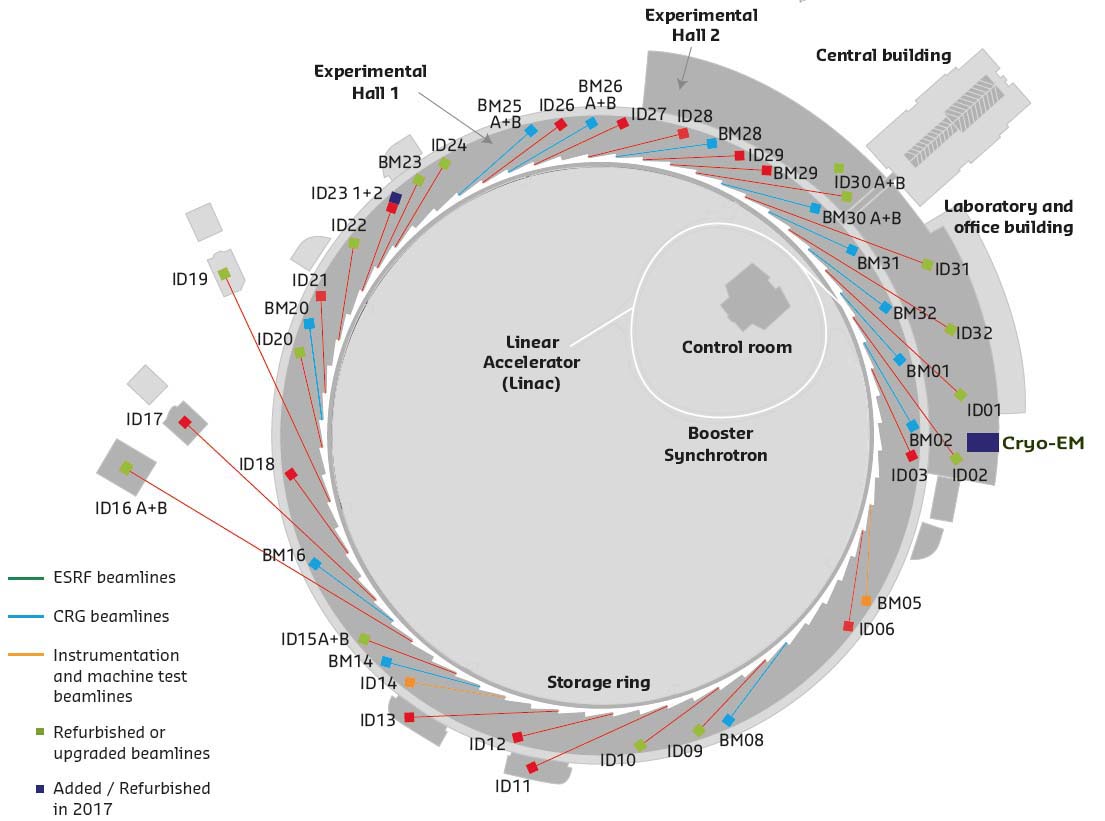 |
|
Fig. 162: Experimental hall showing location of the beamlines (public and CRG beamlines). |
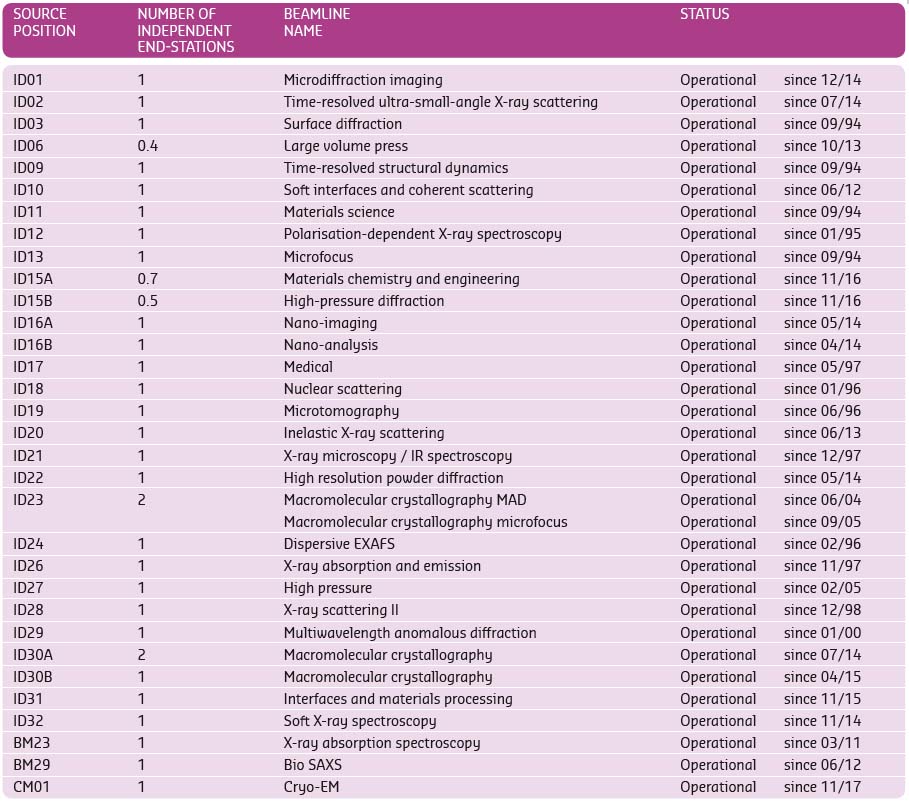 |
|
Table 7: List of the ESRF public beamlines. |
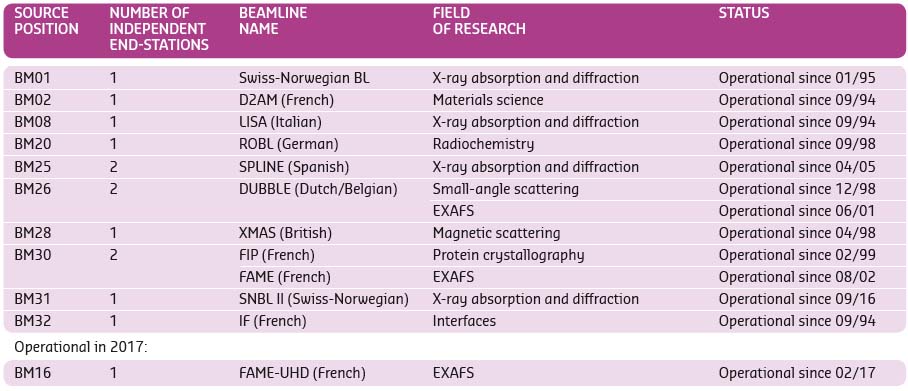 |
|
Table 8: List of the Collaborating Research Group beamlines. |
User Operation
User operation with public beam time at the ESRF in 2017 followed on from a record operation year in 2016, during which all Phase I upgrade programme beamline projects were completed. In 2017, all beamlines were fully operating with the exceptions of the X-ray microscopy beamline, ID21, and the microfocus structural biology beamline, ID23-2, which were both partially closed during this operation year for major refurbishment. BM14 also closed at the end of 2016 and will restart in 2018 as a new CRG beamline operated by the Dutch-Belgian consortium, DUBBLE. The year 2017 has been another record-breaking year in terms of both interest from the user community and provision of beamtime by the ESRF to satisfy the needs of the growing community. Figure 163 shows the number of applications for beamtime received since 2010, and clearly demonstrates the return to full operation following Phase I of the upgrade programme as well as the unprecedented interest from the user community to use the upgraded facilities (nearly 20% increase in requests) in these post-Phase I / pre-EBS operating years.
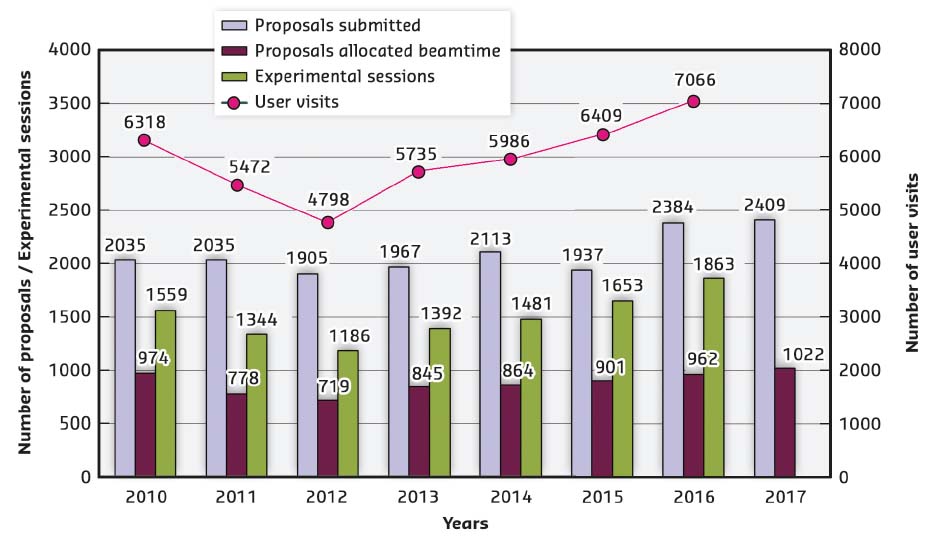 |
|
Fig. 163: Numbers of applications for beamtime, experimental sessions and user visits, 2010 to 2017. N.B. Final numbers of experimental sessions and user visits for 2017 were not available at the time of going to press. |
Proposals for experiments are selected and beamtime allocations are made through peer review. As in previous years, beamtime for 2017 was allocated based on recommendations made by review committees of specialists, for the most part from the ESRF member and associate member countries. These beamline-based committees review all proposals received for a particular beamline, giving them an overview of all the projects proposed for a single beamline and flexibility to optimise the selection of proposals that will be awarded beamtime on each beamline. Proposals for experiments in 2017 were reviewed by 11 review committees, grouping the following beamlines of similar techniques or activities:
• C01 (ID01, ID03, BM25B, BM32)
• C02 (ID11, ID15A, ID22, ID31)
• C03 (ID12, ID32)
• C04 (BM08, BM16, BM20, BM23, BM25A, BM26A, BM30B, BM31)
• C05 (BM01, ID06-LVP, ID15B, ID18, ID27, ID28)
• C06 (ID17, ID19)
• C07 (ID16A, ID16B, ID21)
• C08 (ID02, ID13, BM26B)
• C09 (BM02, ID09, ID10, BM28)
• C10 (Structural biology beamlines)
• C11 (ID20, ID24, ID26)
The scientific areas of the ESRF research activities reviewed by these 11 committees are shown in Table 9.
 |
|
Table 9: Shifts of beamtime requested and allocated for public user experiments, year 2017. |
The review committees met twice during the year, around six weeks after the deadlines for submission of proposals (10 September 2016 and 1 March 2017). They reviewed 2409 applications for beamtime in 2017, an all-time record, and selected 1022 (42.4%) in total. This is the highest ESRF allocation ever, and the first time that more than 1000 proposals could be allocated beam time. Requests for beamtime in 2017, which is scheduled in shifts of eight hours, totalled 34 268 shifts and, of these, 14 752 shifts (43.0%) were allocated. The distribution of shifts requested and allocated by scientific area for 2017 is shown in Table 9, while the number of shifts requested, allocated and delivered per year since 2010 is shown in Figure 164.
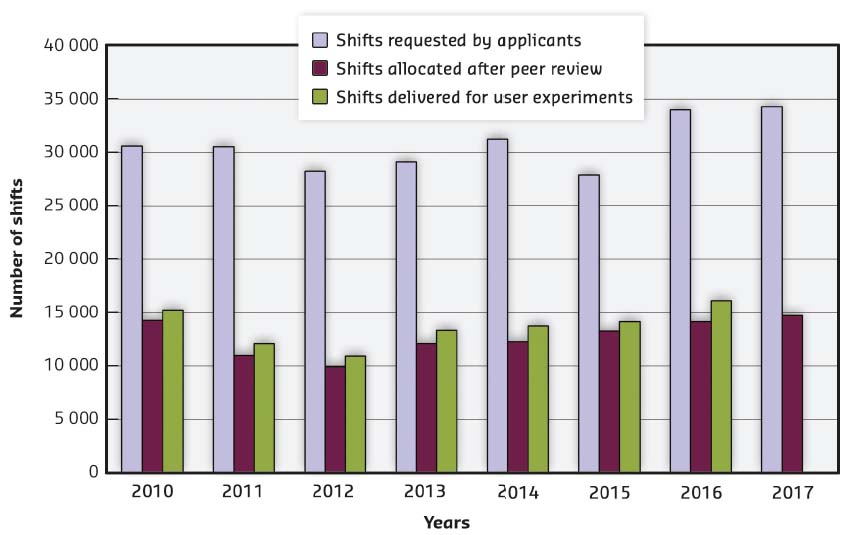 |
|
Fig. 164: Amount of beamtime requested, allocated and delivered, 2010 to 2017. N.B. The final number for beamtime delivered for 2017 was not available at the time of going to press. |
The breakdown of shifts delivered for public experiments by scientific area in the first half of 2017 is shown in Figure 165. This same period saw 3262 visits by scientists to the ESRF under the public user programme, to carry out 864 experiments. Overall, the number of users in each experimental team averaged 3.8 persons and the average duration of an experimental session was 8.5 shifts (less than three shifts for MX experiments and just over 12 shifts for non-MX experiments). Faster and more efficient experiments ensure that more proposals can be accepted, maintaining an acceptance rate of over 40% despite the increase in the number of proposals received. For this same reason, more experiments and users can be supported; the annual number of experimental sessions and user visits since 2010 is shown in Figure 163. Based on beamtime delivered so far in 2017, the number of public experiment sessions for the full year is expected to be close to 1900, with public user visits expected to reach 7000, while the total beamtime delivered for the public user programme is expected to reach 16 400 shifts. These beamtime usage figures are again at record levels, clearly indicating the successful outcome of the first phase of the Upgrade Programme.
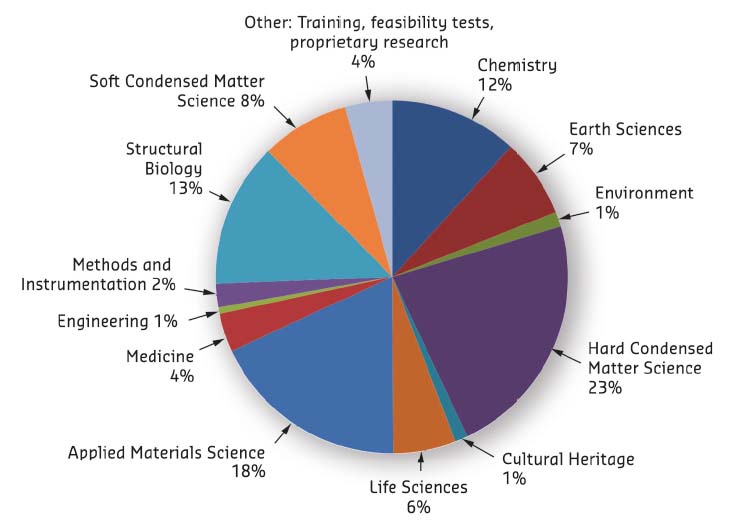 |
|
Fig. 165: Shifts delivered for experiments, March to July 2017, by scientific area, total 7663. |
One of the principal measurable output parameters of the ESRF is the number and quality of publications accepted in peer-reviewed journals. During 2017, the ESRF reached and passed the remarkable milestone of 30 000 publications resulting from data taken either wholly or partially at the ESRF since the facility first opened its doors in 1994. Yearly publication output from the ESRF has been systematically at a level of over 1800 for many years now, as shown in Figure 166. At the time of going to press, 1703 publications had already been registered for 2017, giving a total of 30 528 publications accepted in peer-reviewed journals, and this figure will continue to evolve with the final number for 2017 expected to again surpass 1800. Of these, around 300 every year are published in high impact factor journals. These are excellent figures, showing that the ESRF research output is maintained at a worldwide high.
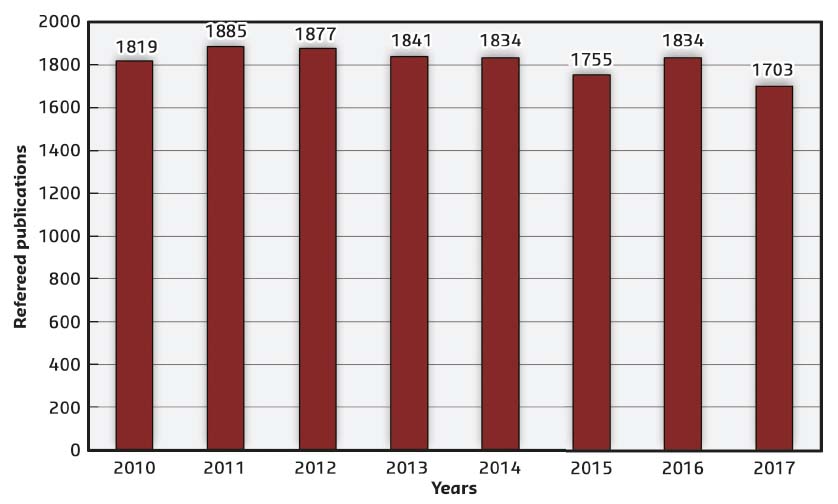 |
|
Fig. 166: Numbers of publications appearing in refereed journals reporting on data collected either partially or totally at the ESRF, 2010 to 2017. The number of publications for 2017 is not final at the time of going to press. |
User responses to questionnaires show once again that the ESRF continues to maintain its excellent reputation concerning the assistance and service given by scientists and support staff at the beamlines, and travel and administrative arrangements, in addition to the quality both of the beam and of the experimental stations. Onsite offline facilities, such as preparation laboratories and collaborative platforms offering complementary techniques and support, provide a vital contribution to the quality of user support but also to the quality of the science and results that can be achieved. Major scientific advances can be made through the collection of complete and complementary data and information on the most important scientific questions. These aspects remain key to the continuing success story of the ESRF.
Administration and finance
The budget for 2017 includes additional contributions from Members and Scientific Associates of 10 997 kEUR dedicated to the ESRF-EBS project. The ESRF-EBS expenditure budget amounts to a total of 39 841 kEUR including 5 311 kEUR of ESRF operating budget.
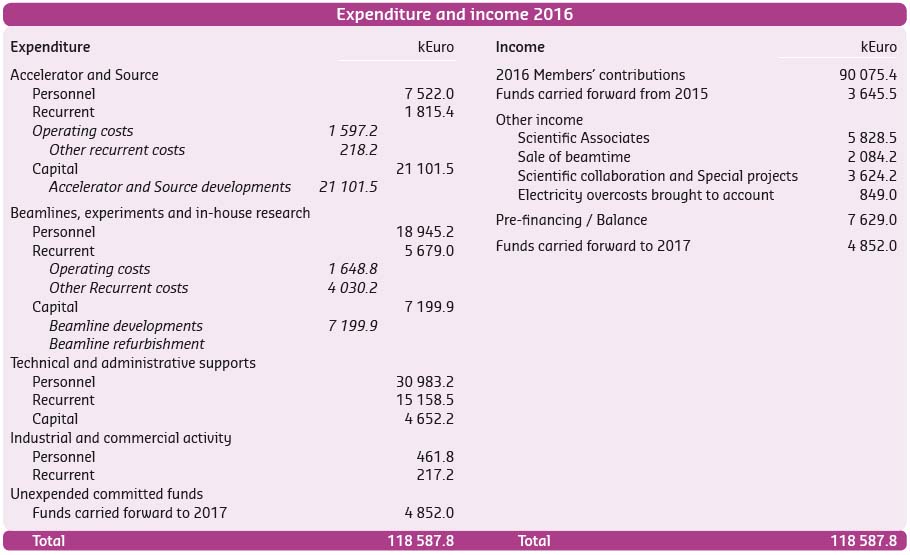 |
|
|
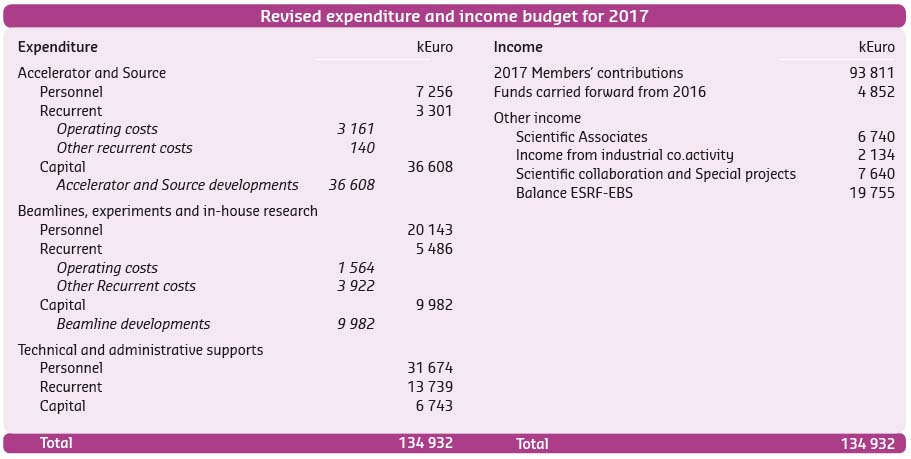 |
|
|
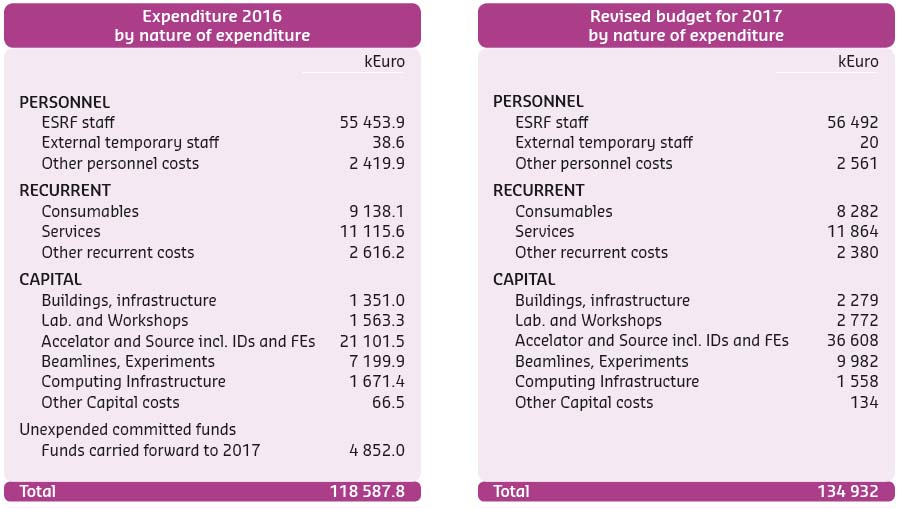 |
|
|
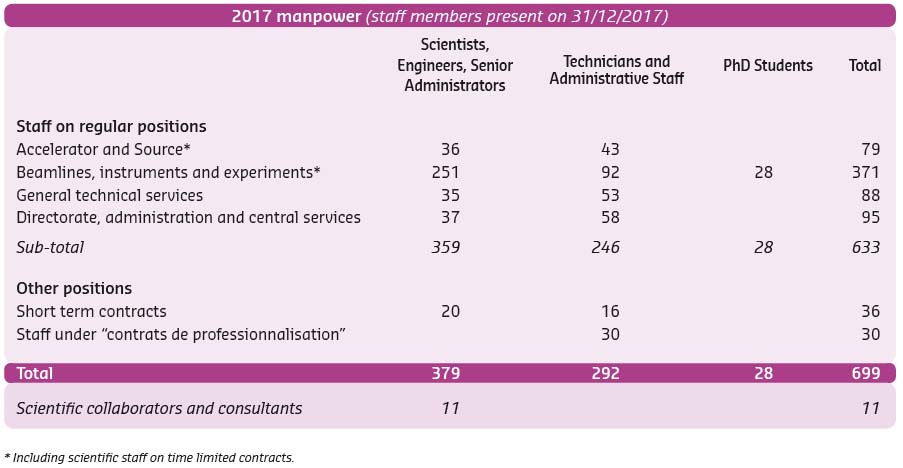 |
|
|
Organisation chart of the ESRF
(as of January 2018)
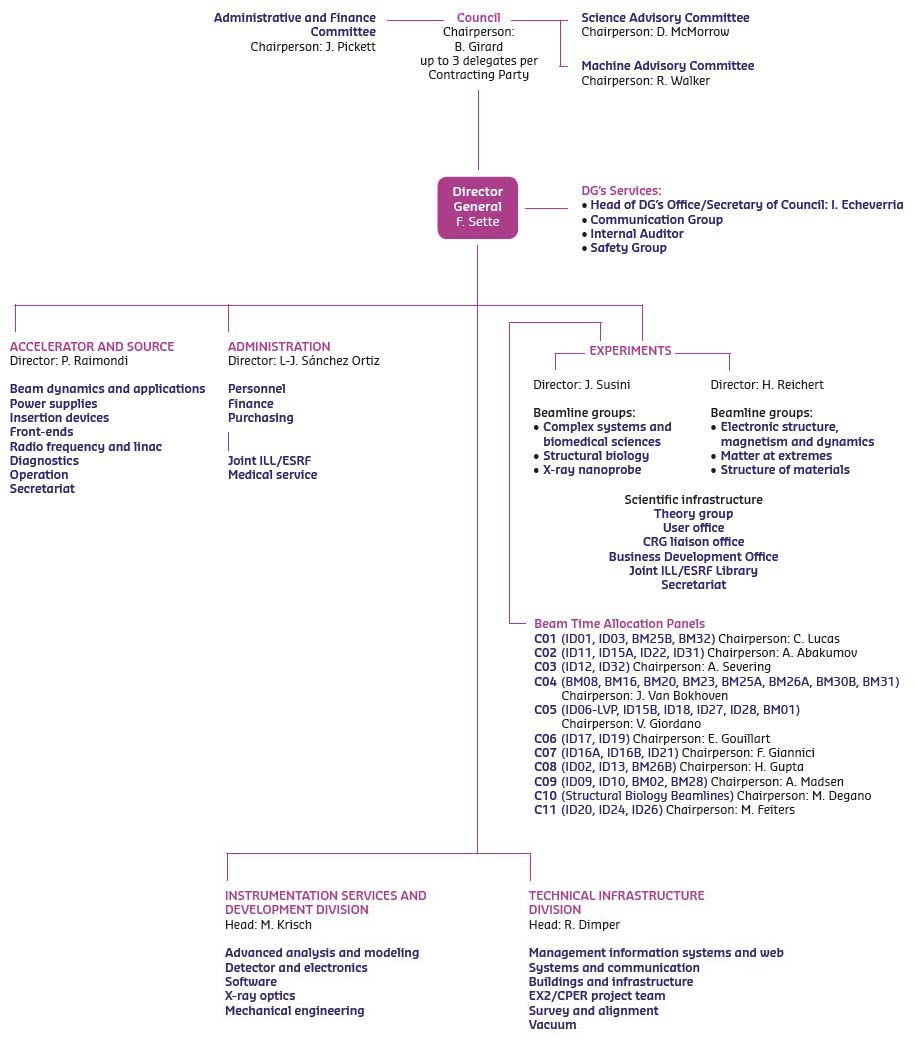 |
|
|



